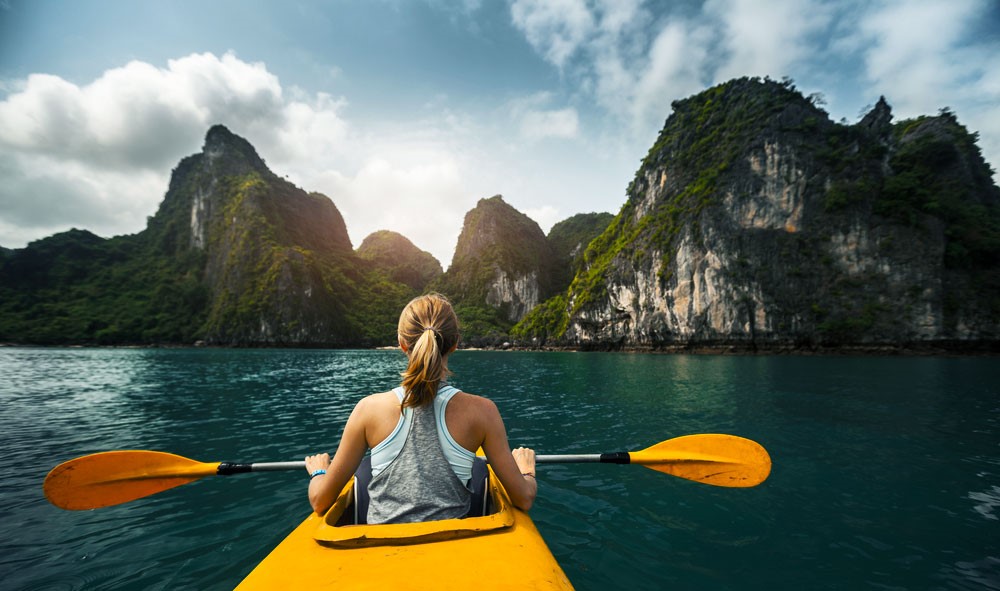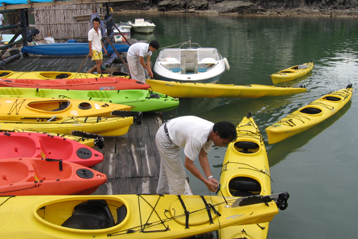How to make your kayak turn
Its more than just stroke left when you want to turn right and vice versa. See our guide for more enjoyable kayaking tours(The video 3 Golden Rules of Recreational Kayaking credit to PaddleTV)
The forward sweep
The forward sweep is much the same stroke as the forward stroke except the blade as drawn back is a wide arc well out to the side of the kayak. The kayak turns to the off-stroke side.
To begin this stroke, rotate the torso, lean forward and place the blade near the side of the kayak up by your feet. Angle the power face of the blade out from the side of the kayak and push the blade away from the side of the kayak. Bring the paddle blade back in a wide arcing motion and continue to rotate your torso. Continue to bring the paddle back until it almost contacts the rear of the kayak. Retrieve the paddle by lifting up just as it gets to the kayak's hull. Turn your head to watch the blade as it arcs back to the kayak. (Always watch your work!) The most effect turning portions of this stroke are beginning and, even more so, the end. The middle portion of the stroke keeps up the forward motion but has little effect on the turn. Do not lean your body or your head to the stroke side, as this will destabilize your kayak. Your body and head should turn, not lean. When sweeping while going forward through the water, tilting (not leaning) the kayak will assist the turning motion.
The reverse or back sweep
The reverse or back sweep is the reverse of the forward sweep. Start the stroke by rotating your body and head to the stern, place the blade with the power face toward the hull of the kayak and sweep the blade out and forward in a long arc culminating at the hull of the kayak near your feet. The kayak will turn toward the stroke side. The stern motion is the most effective portion of the back sweep.
By alternating a forward sweep on one side and a back sweep on the other, you can spin you kayak in place. Long kayaks with little rocker will be harder to turn than short kayaks with a lot of rocker. Tilting the kayak will enhance the rocker effect. The latter can be turned a full 360 degrees in about 15 seconds. How long does it take you to spin yours all the way around? Practice and see if you can shorten the time. This is also a good way for judging a kayak's maneuverability when selecting a kayak.
The stern draw
The stern draw is the same motion as the last portion of the forward sweep. Start by rotating your torso toward the back of the kayak. Place the blade well away from the side of the kayak with the power face toward the hull. Draw the paddle in toward the hull of the kayak. Use this stroke as a correction stroke when adjusting your paddling direction as it does not dampen your forward speed. It will stop a broach in its initial stages but it is not as powerful as a stern rudder in this type of situation.
The stern rudder
The stern rudder is the same motion as the first part of a back sweep. Rotate your torso to the stroke side, put the blade in the water close to the boat at the stern and push or pry the back of the blade out and away. This is an easy way to get a kayak to turn, but it has a braking effect, slowing you down so use it quickly and sparingly. The stern rudder is very effective in stopping a broach. Be careful not to get the blade so deep that you can't snatch it from the water before your sliding stern runs over it and trips.
The bow rudder
The bow rudder uses your paddle blade as a steering plane near your feet to turn the kayak toward the stroke side. Reach forward (not much rotation this time) and place your paddle blade up by your feet. At the same time, move your off-stroke upper hand across the center line of your boat and touch your opposite shoulder with it. Place your lower elbow into your side and angle your forearm angles out about 45 degrees. Bend your wrists back and lower the paddle blade so it enters the water slicing forward with the power face facing the kayak hull. It is important to begin with the edge of the blade parallel to your kayak, Bend the wrists back further and the blade face opens and begins to move away from the kayak. Hold it firmly to the side of the kayak and the kayak will follow the blade in a turn to that side. It should be possible in calm wind conditions to turn the kayak 180 degrees with a single stroke.
More guide...
Responsible Travel
Being a responsible eco tour operator is at the heart of what ACTIVETRAVEL ASIA is all about. From the start, we have been committed to offering low-impact tours that benefit traveler and host alike. We work with local communities, businesses and individuals to develop sustainable tourism opportunities that help local economies while minimizing negative environmental and cultural impacts.
Asia Travel News












